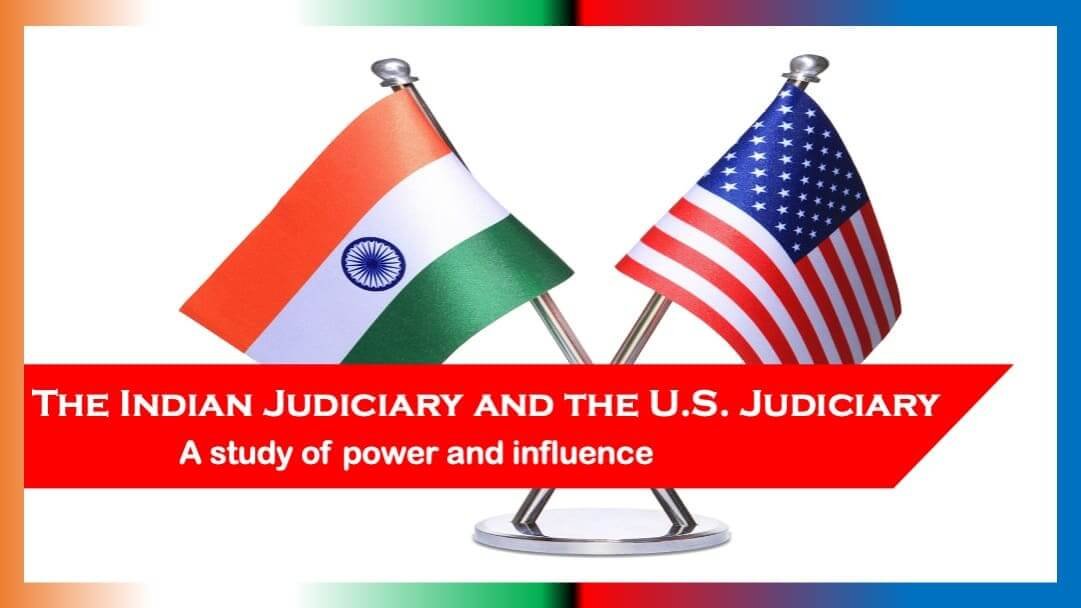The Indian Judiciary and the US Judiciary – A Study of Power and Influence
The judicial branches of India and the United States are fundamental pillars of their respective democratic systems, responsible for interpreting the law, protecting citizens’ rights, and upholding the rule of law.
Both judiciaries play essential roles in their nations’ governance, but they operate under different legal frameworks and constitutional structures. This comparative analysis examines whether the Indian Judiciary is more powerful than the Judiciary in the U.S.A., focusing on various dimensions that define their power and influence.
Constitutional Framework
India
The Indian judiciary derives its authority from the Constitution of India. It has the power of judicial review, allowing it to strike down laws or government actions that violate the Constitution. The doctrine of basic structure, established by the Indian Supreme Court, provides a mechanism to safeguard essential constitutional provisions from being amended or diluted by the legislature.
U.S.A
The U.S. judiciary operates within a federal system of government, with the Constitution of the United States as its supreme law. The power of judicial review was established by the landmark case Marbury v. Madison (1803), giving U.S. federal courts the authority to invalidate laws inconsistent with the Constitution.
Both judiciaries possess the power of judicial review, but India’s basic structure doctrine enhances its authority by protecting core constitutional principles from being altered.
Scope of Jurisdiction
India
The Indian judiciary consists of a three-tiered system: the Supreme Court, High Courts, and District/Subordinate Courts. The Supreme Court has jurisdiction over constitutional matters, disputes between the central and state governments, and appeals from High Courts.
U.S.A.
The U.S. judiciary is organized as a federal system with federal courts, circuit courts of appeal, and the Supreme Court. It hears cases involving federal laws, constitutional issues, and disputes between states.
While both judiciaries have distinct levels of jurisdiction, the U.S. judiciary’s role in interpreting federal laws and constitutional matters is crucial to the nation’s governance.
Appointment and Tenure of Judges
India
Indian Supreme Court judges are appointed by the President of India in consultation with the Chief Justice and other senior judges. They retire at the age of 65. High Court judges are also appointed by the President in consultation with the Chief Justice of India and the Governor of the respective state.
U.S.A
In the United States, federal judges, which include Supreme Court Justices, are appointed by the President & must receive Senate confirmation. Their appointments are for life or until they decide to retire voluntarily, or in cases where impeachment leads to conviction.”
The lifetime tenure of U.S. federal judges enhances their independence, ensuring that their decisions are not influenced by political considerations, making the U.S. Judiciary formidable.
Role in Shaping Policy
India
The Indian judiciary has played a significant role in shaping policy through Public Interest Litigations (PILs) and suo motu actions. It has issued directives on environmental protection, education, and social justice. However, policy implementation remains with the executive and legislative branches.
U.S.A.
In the U.S., the judiciary also plays a policy-shaping role through its interpretations of the Constitution and federal laws. Landmark decisions like Brown v. Board of Education (1954) have had profound societal impacts, but the implementation of policy changes lies with the other branches of government.
Both judiciaries influence policy, but the extent of their direct involvement in policy implementation differs.
System of Oversight
India
The Indian judiciary acts as a check on the executive and legislative branches by ensuring that their actions align with the Constitution. It can strike down laws or government actions deemed unconstitutional.
U.S.A.
The U.S. judiciary, particularly the Supreme Court, serves as a vital check on the other branches by interpreting the Constitution and resolving disputes. Decisions like United States v. Nixon (1974) exemplify the judiciary’s role in upholding constitutional principles.
Both judiciaries maintain a system of checks and balances, preventing any one branch from accumulating excessive power.
Role in Protecting Individual Rights
India
The Indian judiciary, particularly the Supreme Court, has played a significant role in safeguarding individual rights and liberties. It has issued judgments on issues such as privacy (Puttaswamy v. Union of India, 2017) and LGBTQ+ rights (Navtej Singh Johar v. Union of India, 2018).
U.S.A.
The U.S. Supreme Court has a long history of protecting individual rights, as seen in cases like Miranda v. Arizona (1966) and Obergefell v. Hodges (2015) on same-sex marriage.
Both judiciaries have actively defended individual rights, contributing to the protection of civil liberties in their respective countries.
Public Perception and Enforcement of Judgments
India
The Indian judiciary enjoys a high level of public trust, and its judgments are generally respected. However, enforcement can be challenging, with delays and backlogs in the legal system.
U.S.A.
The U.S. judiciary is also highly regarded, with the Supreme Court being a symbol of the nation’s commitment to the rule of law. Compliance with court decisions is generally strong.
Both judiciaries are respected institutions, but India faces challenges related to the timely enforcement of judgments.
Influence Beyond Borders
India
The Indian judiciary’s influence extends to other countries with similar legal systems, particularly in the Commonwealth nations. Indian jurisprudence on issues like environmental protection and human rights has been cited in international courts.
U.S.A.
The U.S. Supreme Court’s decisions have international ramifications, especially in areas such as human rights and international law. Its interpretations of the U.S. Constitution set precedents for constitutional law worldwide.
Both judiciaries have a global impact, but the U.S. Supreme Court’s decisions have broader implications due to the United States’ prominent international role.
Conclusion
In a comparative analysis of the power and influence of the Indian Judiciary and the U.S. Judiciary, it becomes evident that each possesses unique strengths and limitations. While the Indian Judiciary exercises its authority through the basic structure doctrine and its role in shaping policy, the U.S. Judiciary benefits from the lifetime tenure of federal judges and its historical role in safeguarding individual rights.
Ultimately, the question of which judiciary is more powerful depends on the specific criteria used for evaluation. Both judiciaries are crucial in upholding the rule of law, protecting citizens’ rights, and ensuring the proper functioning of their respective democracies.
Frequently Asked Questions
What is the basic structure doctrine in the Indian judiciary?
The basic structure doctrine is a legal principle established by the Indian Supreme Court that safeguards essential constitutional provisions from being amended or diluted by the legislature. It ensures that certain fundamental features of the Indian Constitution remain unalterable.
How are federal judges, including Supreme Court Justices, appointed in the United States?
In the U.S., federal judges, including Supreme Court Justices, are nominated by the President and confirmed by the Senate. This process ensures a separation of powers and involves a thorough examination of nominees’ qualifications and suitability for the judiciary.
What is the significance of the doctrine of judicial review in both India and the United States?
Judicial review is a fundamental power that allows courts to review and potentially invalidate laws or government actions that are inconsistent with the respective countries’ constitutions. It is a crucial mechanism for upholding the rule of law and protecting citizens’ rights in both India and the United States.
How do the Indian and U.S. judiciaries influence legal systems beyond their borders?
Both judiciaries have a global impact, with their decisions cited in international courts and influencing legal discussions worldwide. The U.S. Supreme Court’s interpretations of constitutional law, in particular, set precedents for constitutional jurisprudence internationally.

























